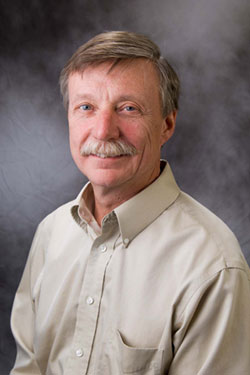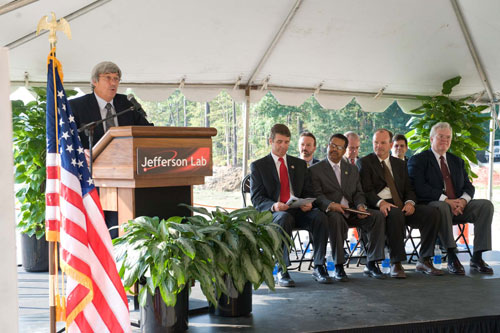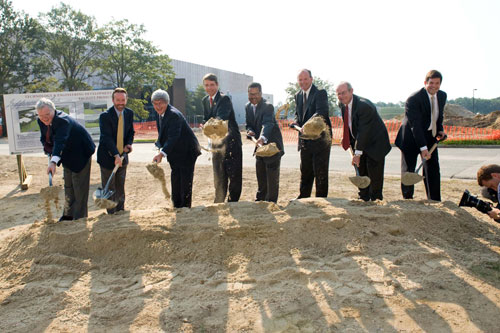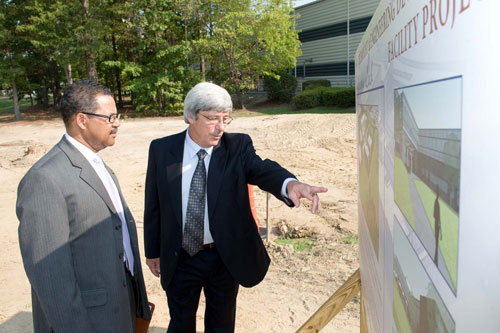
|
September 2010
|
|
|
The U.S. Department of Energy's Thomas Jefferson National Accelerator Facility
|
|
Free-Electron Laser Goes Over the Rainbow |
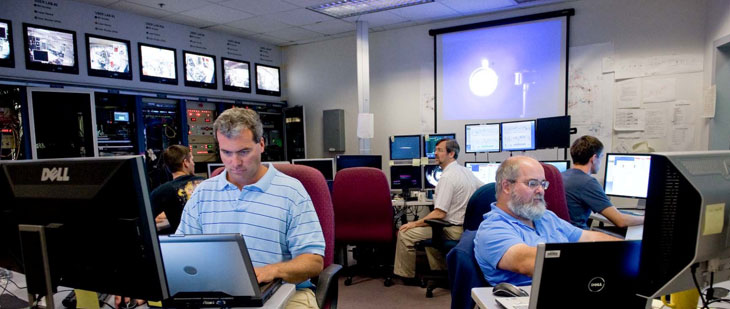 Free-Electron Laser Division members oversee operations from the FEL control room during a UV run earlier this month. Clockwise from the 12 o'clock position: Steve Benson, FEL physics, manages laser operations while Pavel Evtushenko, instrumentation and controls, drives the electron beam. Tom Powers, radiofrequency systems, in the shift operations position; Joe Gubeli, laser systems, and Jim Kortze, I&C, carry out shift operations.
Somewhere over the rainbow of visible light is an untapped goldmine of research potential, where energy, novel materials and environmental research are possible. That goldmine may soon be open to researchers using Jefferson Lab's Free-Electron Laser. The FEL, long known for its high-power beams of infrared laser light, has produced its first beams of ultraviolet light. On Aug. 31, the FEL delivered more than 50 watts of ultraviolet light. "This is the realization of years of hard work by our machine designers and operators," said George Neil, associate director of the FEL Division. "It builds on the Free-Electron Laser's history of innovation." This newest feat opens a new band of the electromagnetic spectrum for experiments. The spectrum separates all the colors of light into bands by wavelength. The FEL was originally commissioned as an infrared laser and is also a prolific source of terahertz light. Together, the infrared and terahertz wavelengths stretch from 1 millimeter to 700 nanometers. Just above these is the visible band: the familiar rainbow consisting of red, orange, yellow, green, blue, indigo, and violet. On the other side of the visible is ultraviolet.... more |
|
|
Deputy Director for Science Excited by JLab Research
|
Wallflowers Become Extroverts in a Crowd
|
Jefferson Lab Breaks Ground for $73.2M TEDF Complex
|
||
|
|
||||
Below the Fold:
Mission Readiness Review Update: The lab has successfully completed its Department of Energy Mission Readiness Review. Look for coverage of the Sept. 8-10 review in the October newsletter. |
||||
Wallflowers Become Extroverts in a Crowd |
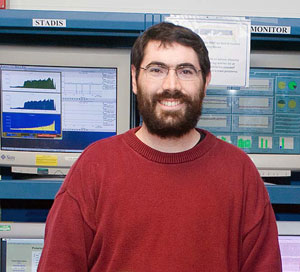 Mike Wood
Assistant Professor, Canisius College, co-spokesperson for experiment E01-112. While it's long been said that two's company and three's a crowd, that's just how mesons like it. A recent experiment at Jefferson Lab demonstrates that these subatomic particles engage more with other particles when in a crowd. This finding is a result of an effort to measure nuclear transparency, or how easy or difficult it is for a particle to travel through the nucleus of the atom. Mike Wood, an assistant professor at Canisius College, is a co-spokesperson for the experiment and lead author on a paper based on the experiment. He says the simplest way to study subatomic particles is to scatter a highly energetic beam of particles off of a single proton. However, many of the experiments at Jefferson Lab produce new particles inside nuclei. A nucleus presents far more crowded conditions: new particles are surrounded by the nucleus' protons and neutrons, and their quarks and gluons. "We wanted to know what happens to a meson that is formed inside a nucleus and is surrounded by the quarks in the protons and neutrons," Wood says. In the experiment, energetic photons were beamed into the nuclei of five targets: deuterium, carbon, titanium, iron and lead. Mesons were produced as the photons smacked into the nucleus. Just like protons and neutrons, mesons are built of quarks. "The experiment studied how many omega and phi mesons escaped nuclei and how many were absorbed due to interactions in the nucleus," he explains. The smallest nucleus the experimenters used was deuterium, an isotope of hydrogen that contains a single proton and neutron. In the middle was carbon, with 12 protons and 12 neutrons. The largest nucleus was lead, with 82 protons and 126 neutrons. Compared to deuterium, the carbon nucleus allowed 80 percent of the mesons to sail through. Lead allowed just 20 percent. Wood said this result is evidence of in-medium modifications. In other words, the more crowded the nucleus is, the more likely that the newly formed mesons will interact with the nucleus' protons and neutrons and not make it all the way through. Hence, in terms of nuclear transparency, the nucleus becomes less transparent to mesons as its numbers of protons and neutrons increase. The new paper featuring the result was published in the Sept. 10 issue of Physical Review Letters. It is one of several to be published by the g7 collaboration, which ran the experiment, E01-112, in Jefferson Lab's Hall B. By Kandice Carter Technical papers: |
Test Run Addresses Feasibility of Dark Matter Experiment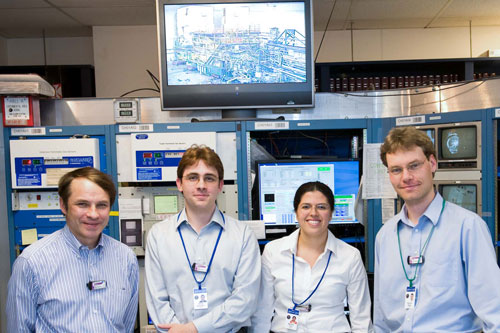 Co-spokespersons for the APEX experiment gathered in the Hall A control room after completing their test run on July 12. Pictured, left to right, are JLab experimentalist Bogdan Wojtsekhowski, Philip Schuster, with the SLAC National Accelerator Laboratory and the Perimeter Institute for Theoretical Physics; Natalia Toro, Stanford University and Perimeter Institute, and Rouven Essig, SLAC
A collaboration's successful experiment test run could result in the approval of the first dark matter experiment to run using Jefferson Lab's Continuous Electron Beam Accelerator Facility. Experiment E12-10-009, titled "Search for a New Vector Boson A' Decaying to e+e−" and dubbed APEX, was conditionally approved by the Program Advisory Committee (PAC) that met Jan. 25-29. A short window in the Hall A schedule was made available during the summer run, and a two-week test run was approved. The test run that ended July 12 sought to provide the collaboration information on the resolution, optics, high-rate detector performance and event rates needed to address specific concerns that the PAC had about the proposal. The original idea for the experiment resulted from a paper by theorists James Bjorken and Rouven Essig, SLAC National Accelerator Laboratory; Philip Schuster, of SLAC and Perimeter Institute for Theoretical Physics, Ontario, Canada; and Natalia Toro, Stanford University and Perimeter Institute. Co-spokespersons Essig, Schuster and Toro worked with JLab experimentalist and co-spokesperson Bogdan Wojtsekhowski to bring the idea to reality. "Bogdan was absolutely crucial in turning it into a realizable proposal with truly outstanding sensitivity to a new particle, and he organized most of the preparation efforts for the test run," Toro noted. "We couldn't have done this without him." The development of ideas for the experiment began soon after the September 2009 "Dark Forces" workshop at SLAC and was completed in December 2009 with the formulation of an advanced proposal to PAC-35. A few weeks after its conditional approval in January 2009, preparation work for a test run began. It included preparing the detectors and target for high-intensity data taking, and a specialized beam line with custom magnets. The group converged at Jefferson Lab in June to prepare for the test run. After the previous experiment completed its run, most of the standard detectors of the spectrometers needed to be re-installed, re-connected and commissioned before the APEX test could start. They, fellow collaborators and Hall A technical staff spent the week of June 21 preparing, installing and adjusting the detectors in the left spectrometer. Over a weekend, the hall received electron beam to conduct detector tests. The next week it was back into the hall to install the right-side spectrometer detectors, make adjustments and set up the trigger for the experiment before closing up to run again the next weekend. "A major achievement of the second week was setting up our trigger to record the small fraction of events where an electron and a positron entered the two spectrometers at the same time – demonstrating the viability of the trigger was one of the main conditions identified by the PAC," Toro explained. At the end of the two-week test run, the collaboration was granted a six-day extension. With the extension, the collaboration believes it was able to address practically all of the issues that the PAC had raised. And the final run, which lasted from about 8 a.m. July 9 to 8 a.m. July 12, progressed so smoothly that the collaboration was able to obtain a limited data set of production quality. "After the first hour of running we were in to new territory," Schuster said. "This is a beautiful example of why CEBAF is the best facility for this physics." Essig, Schuster and Toro left July 12, eager to begin analyzing their data and hoping to achieve full approval to run their experiment. Their experiment presents a search mechanism for the possible mediator of a new force – something akin to electromagnetism – which might mediate the interactions of dark matter with itself and with ordinary matter. According to the researchers' proposal: "Dark matter makes up more than three-quarters of the mass of the universe, but we know very little about it. Recent anomalies from terrestrial, balloon-borne and satellite experiments suggest that dark matter interacts with Standard Model particles. But even more surprisingly, those experiments hint that this interaction is not described by the Standard Model, but by a new 'dark force.'" Data from these experiments hint that dark matter is directly charged under this new force. "APEX at Jefferson Lab will search for this new force, and has the potential to reshape our understanding of our world by addressing one of the outstanding mysteries of our time: the nature of dark matter," Essig commented. The APEX experiment will search for this force by looking for a particle dubbed A', which is thought to carry the force between dark matter and ordinary matter. New to the field of experimental physics, the theorists were surprised by the level of support they received for their experiment. "We now have a much better understanding of what is needed to put together and run an experiment," Toro said. They praised the Hall A technical support staff and the Machine Control Center and Accelerator Operations staff that assisted with the test run. "Everyone was very interested in our experiment and worked hard to help us achieve a successful test run," Essig says. "The support was great and we worked hard to make the most of it." "This was a great opportunity and we feel that everyone's efforts helped achieve the best possible outcome for the test run. We learned a lot from this experience and from the run – from the logistics of running and commissioning an experiment to teamwork," Schuster adds. The APEX collaboration includes U.S. and international researchers. The collaboration grew as other researchers got involved in preparations and installation work leading up to the test run. "Yerevan [Armenia] researchers were critically important in helping to set up and prepare for the test run," Toro said. "And JLab users from universities around the country and abroad, including MIT, the University of Virginia, New York University, Florida International University, the College of William and Mary and Tel Aviv University have been invaluable in running the experiment and in data analysis, as are the contributions of the group from SLAC." "This experiment has generated a great deal of interest and excitement across both particle and nuclear physics. It is looking for new phenomena and has the potential for new discoveries at this energy," Schuster says. "CEBAF's precise and high-intensity beam, along with the high resolution of the Hall A spectrometers, makes this experiment possible." "Never before did I have theory collaborators with such an interest to contribute to the realization of an actual experiment. It is a great team to work with. The recently proposed physics motivation for the A' boson in the mass range below 1 GeV provides a firm foundation for a wide research program," Bogdan Wojtsekhowski concluded. Tech Transfer Helps U.S. Industry, Defense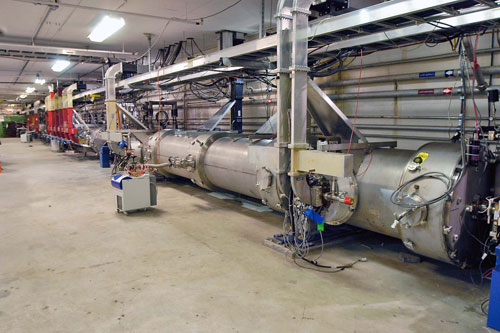 In the FEL, electrons stripped from their atoms are whipped to high energies by a linear accelerator (FEL superconducting radiofrequency croymodules pictured). The electrons are transported in a beamline to a wiggler. The wiggler uses magnetic fields to shake the electrons, forcing them to release some of their energy in the form of photons. The photons bounce between two mirrors in the optical system and this stimulates the electrons to emit coherent light.
Free-electron laser and superconducting radiofrequency advancements at Jefferson Lab are allowing companies like Boeing and Advanced Energy Systems to develop commercial and industrial processes. It’s also paving the way for other uses for these technologies, including energy and environmental advancements and for defense. One example is the Sept. 13 announcement by the Boeing Co. that it received a $23 million tasking from the U.S. Navy to complete the design of the 100-kilowatt Free-Electron Laser lab demonstrator. "This is a fine example of how Jefferson Lab knowledge, skills and capabilities in science and technology are advancing into the U.S., and the international commercial and industrial marketplace," says Roy Whitney, JLab's chief technology officer. "JLab scientists, engineers and technologists have been essential in making groundbreaking advancements in these two technologies and in bringing them to mature, robust levels. This is now allowing business and industry to develop transformative uses for these technologies." Excerpts from the Boeing news release follow: The U.S. Navy's order is the latest step in a design review phase, which is to be completed in late 2011. The design review phase will be followed by additional task orders for fabrication and testing in a laboratory environment. Boeing has selected an existing accelerator facility at Los Alamos National Laboratory for the assembly and testing of the FEL lab demonstrator. This task order of $23 million to complete the design of the 100-kilowatt Free Electron Laser lab demonstrator is part of a Navy contract, valued at up to $163 million, which is the result of a competitive selection based on preliminary designs provided in March. "The Free Electron Laser program will enable Navy ships to defend themselves against new threats with unprecedented speed, precision and power," said Greg Hyslop, vice president and general manager of Boeing Strategic Missile & Defense Systems. "It will transform naval warfare in the next decade by providing an ultra-precise, speed-of-light capability and unlimited magazine depth." An FEL operates by passing a beam of high-energy electrons through a series of powerful magnetic fields, generating an intense emission of laser light. "Two unique attributes of FELs are the ability to tune the wavelength to maximize transmission of the laser through the marine atmosphere, and the ability to aim for a single small spot on the target," said Ed Pogue, FEL program manager for Boeing. "The combination of these two effects allows the system to destroy the target in the minimum time." Boeing is partnering on FEL development with U.S. Department of Energy laboratories, academia and industry. The laboratories include Jefferson Lab, Los Alamos National Lab and Argonne National Lab. Major industrial partners include Advanced Energy Systems, Niowave Inc. and SAIC. The complete Boeing news release is at: GWU Student Wins JSA Undergrad Research Assistantship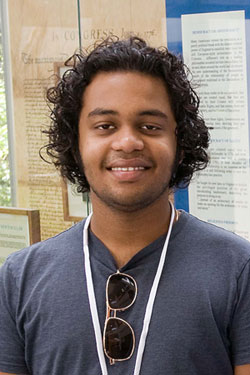 Arun Selvaratnam
George Washington University, JSA Undergraduate Research Assistant From the time he was a youngster attending Catholic school in Brooklyn, N.Y., Arun Selvaratnam, was the kind of student who took home as many books as the library would allow. A voracious reader and lover of science and math, by the time he was ready for high school he was also ready to take on his first academic challenge: he applied to New York City's Stuyvesant High School for Math and Science and was accepted. He took eight Advanced Placement courses and, in his junior year, took his first course in physics. "It really got to the core of how the universe works," he recalled. "Every other discipline I had studied, I wanted to go deeper. I kept wondering 'Why? Why?' and when I got to physics I found the answers there." In his senior year, he took AP Physics C, a course that taught him calculus through physics before he had ever taken that math course. "My high school was a great environment for learning," he noted. "All the students were really, really smart and the teachers were great." When he entered George Washington University, he was unsure of his major and actually envisioned that he might end up in the social sciences. That thought was quickly dismissed. "I found that I wasn't impressed as I had been with physics," he said. "It's too young a science for me. I was looking for those rigorous answers." He switched his major to physics and found that the more he learned, the more his passion for it increased. "My favorite was modern physics, with the introduction of quantum physics," he noted. "Quantum was really hard, but relativity was really cool." This summer, Selvaratnam was selected to participate in the Jefferson Science Associates' Undergraduate Research Assistantship Program for Minority Science and Engineering Students at Jefferson Lab. He was nominated by William J. Briscoe, director of the George Washington Center for Nuclear Studies, who referred to Selvaratnam as "one of our best undergraduate physics majors" and suggested that he have the opportunity to work on the Frozen Spin Target, or FROST, experiment at Jefferson Lab, where he would also have the opportunity to work with two GWU graduate students. Under the assistantship, funded through the JSA Initiatives Fund, the junior physics major worked at the lab from June 28 to Aug. 25. JSA Fund Supports Minority Assistantship at JLab
The Jefferson Science Associates' Research Assistantship Program for Minority Science and Engineering Students at Jefferson Lab offers opportunities and support to minorities and underrepresented students pursuing undergraduate degrees in engineering and science at SURA universities. Criteria for selection are based on scientific qualifications (projects related to Jefferson Lab research) and the academic record of the nominated students. JSA provides funds through the the JSA Initiatives Fund Program to support the student at the university during the academic year, and money to visit Jefferson Lab; combined this award can total $9,000. Additional information about this research assistantship may be found at: http://www.jlab.org/div_dept/admin/HR/research. JSA is a joint venture between the Southeastern Universities Research Association and CSC Applied Technologies to operate and manage Jefferson Lab for the U.S. Department of Energy. "I had no idea what being a physicist would really be like, and this was a good opportunity to find out," Selvaratnam said. "And this is a great lab to start my real-world experience." In addition to his work in physics, Selvaratnam has taken four years of Japanese and hopes to travel to that country in the near future. "I would like to go from being proficient to being fluent," he said. He's also added pre-med studies to his curriculum, with the intention of following his cardiologist father's path. "Watching my father throughout my life, I really like the comfort that doctors bring to people. It's scary to be sick, and doctors are the ones who have the answers for their patients," he said. He's also played saxophone since he was 10, and played guitar and bass in a rock band while he was in high school. "If you were successful at that," he said with a laugh, "it would be even better than being a doctor." He plans to take a year off after graduation, but to Selvaratnam "a year off" will be a busy one indeed. "I just heard about some opportunities in medical physics research, and that would be ideal for me," he noted. His summer experience at JLab has been gratifying, fruitful and eye opening. "I think it's been really good," he said. "I thought it might be boring, but it definitely was not. Everyone has been really helpful, and I've made some friends. It was a comfortable environment for me; there are lots of international kids here." By Judi Tull Introducing JLab's New Property Manager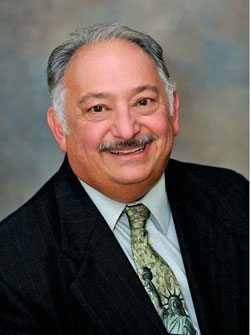 Carl Iannacone
Property Manager "If it's moveable, it's under the purview of Property Management," quipped Jefferson Lab's new property manager, Carl Iannacone. "There's tons of stuff going on right now; and the lab's current construction projects present a unique challenge with people and equipment being moved around," he added. "This kind of work [property management] is all about the details, and the details have to be right." Much of his new position is similar to his previous one as director of Campus Material Management at the University of Arkansas for Medical Sciences. He's accustomed to dealing with research equipment, security issues and multiple facilities. At his previous job since 1992, Iannacone was responsible for conducting the first complete audit carried out in the university’s 100-plus years. "We had to physically pull the metal tags off everything, including door sills, and replace them with bar codes, and we had to keep the metal tags to prove what had been there," he recalled. This energetic native Floridian has never been one to shy away from a tough task. Within five months, the audit was done. And in a matter of two years, he had completely automated the property management department and brought the whole project in under budget. During his tenure there, Iannacone supervised a staff of 40 and managed all the property and distribution for the massive medical center, which has grown to 12,000 rooms and outpatient clinics, and increased its staff from 3,500 to 10,000. By 1996, he decided to become involved in the National Property Management Association (NPMA) and founded the first-ever local chapter in Arkansas. By 2000, he was already making a name for himself in the organization and was re-elected to two two-year terms as central regional vice president and then rose to vice president of marketing and communications for four years. He was elected as executive vice president in 2007 and last year was elected president of the organization, which has more than 4,000 members worldwide. Part of the NPMA’s commitment to its members is hosting a job bank on its website, and it was there that, earlier this year, Iannacone spotted the announcement seeking applications for the Property Management director position at Jefferson Lab. He started work on Aug. 2. "I knew this was a wonderful opportunity," he said, "and it seemed destined to be. Our house in Arkansas sold at full price in just two days, and our real estate agent here is the brother of a friend in NPMA." Iannacone's wife, Brenda, was formerly an administrative assistant in the College of Pathology at the University of Arkansas; she's also a novelist, writing under the name Breanna Cone. (If you say it out loud you’ll get the play on the couple's last name.) She started out writing romances, did one children's book based on the couple's dogs, and now writes murder mysteries, which is right up her husband's alley. He's an avid reader of that genre and often proofreads her work. "Sometimes she takes my suggestions, sometimes she doesn't," he said with a smile and shrug. "After all, it's her book." He's also a movie buff, with more than 700 DVDs in his collection. The "Godfather" ranks first on his list, but it's not all mafia and hit men; he also has the full original "Star Trek" series. During his time in Arkansas, he went back to school and earned his master's in public administration in 1999 and realized, he said, what his true calling was teaching. As an adjunct professor, he taught Introduction to National Government, a required course for freshman, and Introduction to Public Administration, a senior level course, at the University of Arkansas at Little Rock. After being "landlocked" for nearly two decades, Iannacone is thrilled to be back on a coast and near the water. And he's settling in to his new position. Working under Rusty Sprouse, Iannacone is tasked with supervising 10 staff members, tracking inventory and storing equipment, from single office computers to giant compressors, and overseeing shipping and receiving. One adjustment, however, is learning the lab's acronyms. "It's taking me a while to figure all those out," he laughed. By Judi Tull Help Prevent Pilfering of RecyclablesCopper and other metals continue to be a favorite of thieves in Newport News and your involvement is needed to protect these materials from being pilfered at Jefferson Lab, says lab Security Officer Kris Burrows. Metals are favorites because the recycling industry offers high prices, ownership of materials are hard to trace and remnants can be quickly converted to cash, according to Burrows. Newport News Police report that utilities, contractors and home owners have been hit hard this year because recycling prices have risen and thieves are becoming increasingly daring and innovative. The thefts have resulted in the loss of thousands of dollars and increased costs of doing business across Hampton Roads. Newport News Police have been working with businesses and advise using integrated protection strategies to deter theft and to frustrate materials scavengers. According to Burrows, all JLab contracts and construction/maintenance work plans should strongly emphasize that taking materials from the job site without written authorization of the owner is a crime and will be treated as such by all parties. Examples include zero tolerance for personal scrap-metal collection on the job site, debarment from the work site for companies and individuals who do not cooperate in loss prevention initiatives and theft investigations, and formal prosecution for theft by individuals who take materials from the worksite without written approval of a designated official such as a contracting officer, foreman, property official, or homeowner. Jefferson Lab project managers and contracting officials should advise companies and workers that metal scrap collection for personal use is not permitted in any form at JLab. This means a worker's employment may be terminated and/or barred from entry to JLab property for taking any building materials, supplies or scraps from the work site for resale or for any form of personnel gain. All work planning involving excess metal materials at JLab should include policing up the job site and promptly placing excess materials in the metal recycling containers in the JLab Central Materials Storage Area. Persons who remove materials from the JLab metal collection containers without permission may be disciplined, prosecuted or barred from entering JLab. Materials to be claimed by construction/service contractors require a written procedure to be followed by contract workers to centrally collect and dispose of materials in a manner approved by that contract's JLab contracting officer and endorsed by an authorized senior company official. Contracting officers and project managers should provide copies of the service/construction contract procedures to JLab Security. Questions should be referred to Kris Burrows, ext. 7548, burrows@jlab.org, or Mike Lewellen, ext. 7169, lewellen@jlab.org. Using integrated security management, JLab Security will continue vehicle inspection procedures and employ electronic video systems at storage areas and key traffic control points. Members of the JLab community can help by storing materials in a manner that will deter theft, disposing of materials in approved JLab recycling collection containers and reporting suspicious persons and activities to JLab Security at ext. 5822. Get Property Pass Before Taking Equipment, Components OffsiteThe JLab Property Management group is often asked if Jefferson Lab equipment can be taken offsite for official business. The answer is "yes," but only with a valid JLab Property Pass, according to Property Manager Carl J. Iannacone. The process to obtain a property pass is twofold and is easy to complete, he notes. The first step requires getting an approved Jefferson Lab Property Pass Authorization Form. This form can be accessed from the property webpage at: http://www.jlab.org/fm/property/ under Property Forms. The custodian listed in the property records of the items to be taken off of JLab property must sign this form. The authorization form specifies the terms and conditions for use of the Jefferson Lab property while it is offsite. The form must include a brief description of the Jefferson Lab work or activity the employee will be performing offsite. By signing the form the Jefferson Lab employee accepts the terms and conditions of the agreement. Once the authorization form is completed it must be presented to Property Management and a property pass will then be issued. The property pass can be issued for any period of time up to one year. A property pass is required for all laptop computers being taken off of JLab property. A person must have their property pass with them when transporting the equipment off Jefferson Lab. Security guards have been instructed to ask to see the property pass for any lab equipment observed in personal vehicles. Some items are exempt from a property pass; these include: cellular telephones, PDAs, pagers, reports, books, computer diskettes, memory sticks and thumb or flash drives. The policy governing these requirements is in Section 3.15 of the Property Management Policy and Procedures manual; the manual is accessible from the property webpage at: http://www.jlab.org/fm/property/. Questions concerning Property Passes or any property issue may be directed to the property office at ext. 6270 or 7688, or contact Iannacone at ext. 5430 or email carlji@jlab.org. Red Cross Blood Drive at JLab on Oct. 5The Red Cross will hold a blood drive at JLab on Tuesday Oct. 5, from 10 a.m. to 4 p.m. in CEBAF Center room F113. New and repeat donors are encouraged to attend. Walk-ins are welcome; however, making an appointment allows the Red Cross to schedule adequate staff for the visit. Volunteers are also needed to provide administrative help with the blood drive. The July 28 Red Cross Blood Drive was successful, she reports. A total of 61 people signed up to donate blood. There were some deferrals for various reasons; however, the Red Cross still collected 52 pints of whole blood and two donations of red cells using the Double Red process, so the lab exceeded its goal of 45 units, according to Banks. "Jefferson Lab made a significant contribution to the American Red Cross," she said. "We would like to extend a sincere thank you to everyone that participated with this blood drive." Milestones for August 2010Hello Goodbye Correction to Hello entry from the July 2010 On Target: These Milestone entries, listed alphabetically, are full-time, term, casual and student actions posted by Human Resources for August 2010. Jefferson Lab is currently seeking qualified individuals for engineering positions as well some scientific, managerial, technical, administrative and student positions. More than 20 JLab employment opportunities are posted at: http://www.jlab-jobs.com/. Congratulations Tony Lumanog, Facilities Management & Logistics, received his Certified Professional Property Specialist, or CPPS, designation on Sept. 3. Skopik Receives Honorary Degree from University of SaskatchewanOn June 2, Dennis Skopik, the Experimental Nuclear Physics Division's deputy associate director, received an Honorary Doctorate of Science from the University of Saskatchewan. As a professor and scientist at the University of Saskatchewan, and now at Jefferson Lab, Skopik has made major contributions to the science of nuclear physics. Of particular significance and impact to the University of Saskatchewan, Canada and the nuclear physics community, Skopik led the team that established the Canadian Light Source synchrotron at the University of Saskatchewan. Skopik joined the U of S Department of Physics in 1970, and became a full professor in 1979 at the age of 37. He later became the director of the Saskatchewan Accelerator Laboratory and served in that capacity until 1999. His peers elected him as a Fellow of the American Physics Society in recognition of his contributions to nuclear physics. His advice is widely sought by numerous physics laboratories and organizations throughout the world. JSA/Jefferson Lab Graduate Fellowship Awards AnnouncedJefferson Sciences Associates awarded seven JSA/Jefferson Lab graduate fellowships for research related to the science program at Jefferson Lab for the 2010-2011 academic year. The following graduate students from SURA-member universities are working with JLab scientists on their research proposals: First established by the Southeastern Universities Research Associate Board of Trustees in 1989, this graduate fellowship program has been continued by JSA for doctoral students at SURA-member universities conducting research related to the theoretical and experimental programs at Jefferson Lab, including nuclear and related particle physics, accelerator physics, and the laboratory's free-electron laser program. Since program inception, 156 fellowships have been awarded to graduate students from 19 different SURA member universities. Each fellowship award is comprised of one-half of an academic year research assistant stipend, plus a $2,000 supplement. The home institution matches half of the research assistantship. An additional $2,000 is available for research related travel support for the student. The review committee was chaired by JSA Programs Committee chair and JSA Board Director June Matthews, Massachusetts Institute of Technology and included: Hari Areti, JLab; Rolf Ent, JLab; David Ernst, Vanderbilt University; Gerard Gilfoyle, University of Richmond; Keith Griffioen, College of William and Mary; Zein-Eddine Meziani, Temple University; Stephen Wallace, University of Maryland and Elizabeth Lawson, SURA. "JSA is pleased that these students are involved with the JLab science program and approved experiments. One of the primary goals of the JSA/JLab Fellowship Program is to provide opportunities for qualified students to enhance their research capabilities by linking their academic studies with the lab's science," said Matthews. "The research proposals of this year's awardees are clearly focused on important experiments at the lab." The JSA/JLab Graduate Fellowship Program is supported by the JSA Initiatives Fund and administered by the SURA Office of Strategic Services for the JSA Programs Committee. DOE Technology Transfer Coordinator Visits JLab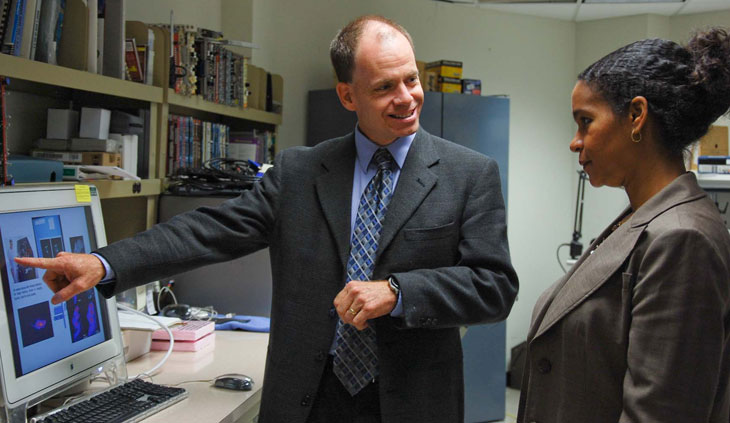 Drew Weisenberger, head of the Radiation Detector and Imaging Group, discusses his group's technology transfer projects with Karina Edmonds, the Department of Energy's Technology Transfer Coordinator. She visited on Aug. 27, met lab and DOE site office leadership and the members of the lab's Technology Review Committee. She toured the lab and met with representatives of Dilon Diagnostics and the Hampton Roads Research Partnership. Edmonds is responsible for working with the DOE's national laboratories to accelerate the process of moving discoveries from the laboratory to the private sector.
Fall Lectures Feature Life of Einstein; Exploring Our World With Particle AcceleratorsJefferson Lab's first 2010 Fall Science Series lecture, "Einstein For Everyone," is set for Tuesday, Oct. 5, and will feature the life, challenges and achievements of the young Albert Einstein. Einstein was a rebel who seemed doomed to fail, according to guest lecturer Robert Piccioni, author of "Everyone's Guide to Atoms, Einstein and the Universe." Piccioni, who has a Ph.D. in High Energy Physics from Stanford University, was a faculty member at Harvard University and did research at the Stanford Linear Accelerator in Calif., will discuss: how Einstein overcame rejection to become the most famous scientist in history. He will explain Einstein's theories in plain English and without math, and show how Einstein's achievements impact our lives through DVDs, GPS, iPods, computers and green energy. Then, on Tuesday, Nov. 23, James E. Brau, University of Oregon, will present "The Mysterious Universe - Exploring Our World with Particle Accelerators." The universe is dark and mysterious, more so than even Einstein imagined, Brau says. While modern science has established an understanding of ordinary matter, scientists now know that previously unidentified elements (dark matter and dark energy) dominate the structure of the universe, its behavior and its destiny. Brau will discuss how researchers are working address these unknowns with experiments at particle accelerators. Results of this research may revolutionize our view of nature as dramatically as the advances of Einstein and other quantum pioneers, according to Brau. He will introduce the questions being advanced, the research facilities being used to study these mysteries and discuss our current understanding of the underlying science. The presentation will be at an introductory level, appropriate for anyone interested in physics and astronomy. The lectures are free and open to students and adults with an interest in science. All lectures begin at 7 p.m., in the CEBAF Center auditorium located at 12000 Jefferson Ave, Newport News, and last for about an hour. Seating in the auditorium and overflow area is available on a first-come, first-served basis and is limited to about 300 people. People arriving once capacity has been reached will be turned away. All those under age 16 must be accompanied by a parent or responsible adult. For security purposes, enter at Jefferson Lab's main entrance (Onnes Drive.). Everyone over 16 is asked to carry a valid photo ID. Security guards may perform ID, parcel and vehicle checks. For directions and additional information about Jefferson Lab public lectures, visit http://education.jlab.org/scienceseries/index.php, or contact Christine Wheeler, e-mail wheelerc@jlab.org or call 757-269-7560. A live video stream is available for those not able to attend in person. Lectures will be added to the video archive for on-demand viewing upon approval from the presenter. Jefferson Lab is one of 17 U.S. Department of Energy national research laboratories and facilities. It is managed and operated by Jefferson Science Associates, LLC for the DOE’s Office of Science. |
|
The On Target newsletter is published monthly by the Thomas Jefferson National Accelerator Facility (Jefferson Lab), a nuclear physics research laboratory in Newport News, Virginia, operated by Jefferson Science Associates, LLC, for the U.S. Department of Energy's Office of Science. Possible news items and ideas for future stories may be emailed to jlabinfo@jlab.org, or sent to the Jefferson Lab Public Affairs Office, Suite 15, 12000 Jefferson Avenue, Newport News, VA 23606
|


 Robert "Bob" McKeown is no stranger to Jefferson Lab. The Jefferson Lab deputy director for science first came here in the mid-1980s for CEBAF summer workshops and found himself enthralled with the work and the types of experiments being proposed. That excitement hasn't left him.......
Robert "Bob" McKeown is no stranger to Jefferson Lab. The Jefferson Lab deputy director for science first came here in the mid-1980s for CEBAF summer workshops and found himself enthralled with the work and the types of experiments being proposed. That excitement hasn't left him....... While it's long been said that two's company and three's a crowd, that's just how mesons like it. A recent experiment at Jefferson Lab demonstrates that these subatomic particles engage more with other particles when in a crowd......
While it's long been said that two's company and three's a crowd, that's just how mesons like it. A recent experiment at Jefferson Lab demonstrates that these subatomic particles engage more with other particles when in a crowd......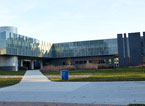 Hundreds turned out on Sept. 1 to celebrate Jefferson Lab's groundbreaking for its new $73.2 million Technology and Engineering Development Facility, or TEDF......
Hundreds turned out on Sept. 1 to celebrate Jefferson Lab's groundbreaking for its new $73.2 million Technology and Engineering Development Facility, or TEDF...... Not shown to scale.
Not shown to scale.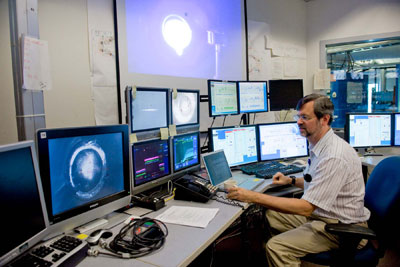 Steve Benson, Free-Electron Laser physics, manages UV lasing operations from the FEL control room during a run earlier this month.
Steve Benson, Free-Electron Laser physics, manages UV lasing operations from the FEL control room during a run earlier this month.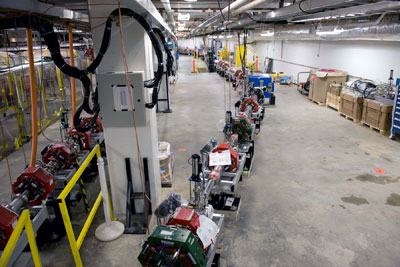 The FEL ultraviolet beamline, with prominent red and green magnets, juts out to the right. On the left, the infrared beamline also extends nearly the length of the room.
The FEL ultraviolet beamline, with prominent red and green magnets, juts out to the right. On the left, the infrared beamline also extends nearly the length of the room.